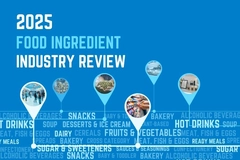
- Industry news
Industry news
- Category news
Category news
- Reports
- Key trends
- Multimedia
- Journal
- Events
- Suppliers
- Home
- Industry news
Industry news
- Category news
Category news
- Reports
- Key trends
- Multimedia
- Events
- Suppliers
“Taste is king”: Flexitarian consumers driving innovation for meat and dairy alternatives

03 Aug 2022 --- Innovation across the plant-based field is moving at warp speed, with companies experimenting with new ingredients, striving to meet the pillars of consumer demand: nutrition, taste, flavor and texture.
With a growing base of flexitarian consumers, the food crisis and environmental sustainability demands are shaking up the market. FoodIngredientsFirst speaks to industry players from Kerry, ADM, Corbion, GNT, Synergy and Univar Solutions on what these changes are and how they’re shaping up the space.
“The current food landscape is very much changing the way consumers are looking at food,” underscores Mike Haracz, corporate chef development lead, North America, Food Ingredients for Foodology by Univar Solutions.
“Although traditional meat and dairy items are growing in costs, the difference between the traditional items and their plant-based counterparts aren’t drastic enough for consumers to fully switch their diets.”

 Flavor, taste and texture are key for meat alternatives.Tightening competition
Flavor, taste and texture are key for meat alternatives.Tightening competition
With inflation continuing to bump up the prices across the whole industry, consumers will be looking toward food options that offer the best value for money, and manufacturers will need to prove that their products are worth the cost, Natalie Sheil, European category manager at Synergy Flavours, highlights.
“Traditionally, plant-based alternatives have been more expensive than their meat or dairy counterparts. But as competition increases and big retailers like Tesco commit to making plant-based diets more affordable and accessible, the gap is closing. Looking forward, as meat alternative prices continue to drop, we expect to see much closer competition between meat and alternatives.”
According to Haracz, there is a growing number of flexitarian households integrating plant-based products into their diets while still utilizing traditional animal-based protein sources. “(Environmental) sustainability is also a driver in increased usage of plant-based protein, as the environmental impact of the food, beverage and household goods consumers use are changing the landscape of what people purchase.”
Megan Passman, global insights manager at Corbion, underscores prices for meat alternatives are going up, along with traditional meat products. “Inflation is impacting everyone, no matter if you are a meat eater, a vegetarian or a flexitarian.”
Taste is king
One of the primary factors driving interest in meat and dairy alternatives lies in its health benefits, such as lowering cholesterol and lowering high blood pressure, Passman adds. Animal and environmental welfare and securing the food supply in an unstable and unpredictable world are also key, she notes.
Jacquelyn Schuh, global marketing director, Protein Nutrition Solutions at ADM, highlights consumers are interested in ingredient diversity, with a focus on nutritional impact as well as protein diversity and quality.
“While nutrition might drive consumers toward alternative meat and dairy products, taste and texture must not be overlooked.” When formulating plant-based meat and dairy alternatives, it’s important to perfect and replicate the “bite and chew” or “sip and mouthfeel” consumers expect in traditional meat or dairy experiences to lower the barrier to entry and encourage return purchases, she explains.
“Taste is king. This isn’t just about flavor. It’s about a full taste experience that delights consumers. Plant-based meat alternatives must be savory and have a similar texture to meat, and plant-based ice cream must be sweet and creamy. With innovations, the bar has been raised on consumers’ expectations of plant-based products,” explains Nicola Weldon, strategy director for plant-based, Kerry Europe.
Furthermore, color, in particular, is seen as “vital” to make a positive first impression on consumers, says Steven Taylor, key account manager, GNT Group. “If a plant-based burger looks like a beefburger, it helps build consumer acceptance and expectations of product quality. It even influences enjoyment – the hue and intensity of food colors affect the perception of flavor and aroma.” Where cheese is concerned, consumers have high demands for their dairy alternative options.
Where cheese is concerned, consumers have high demands for their dairy alternative options.
Sea-ing ahead
Plant-based fish and seafood is a category that is growing strongly off a relatively small base, Weldon adds.
“The consumer drivers are slightly different here versus meat alternatives - consumers are looking to reduce their consumption of meat for health reasons, but fish and seafood are generally perceived as healthy. The opportunity is more driven by consumer needs around environment/sustainability.”
According to Sheil, the fish alternative market is seeing increasing traction in products such as plant-based salmon, tuna and even seafood such as calamari and prawns, to expand plant-based offerings.
“This rise in product development is due to the increasing understanding of plant-based proteins and how they behave, alongside continued innovation in flavor technology, which allows manufacturers to break the boundaries of what was previously possible in this space.”
Within the sphere, Taylor explains the company has been able to develop effective, clean-label coloring solutions for a wide range of seafood alternatives, including plant-based salmon and tuna steaks, smoked salmon, prawns, canned tuna and even caviar.
Market gaps
According to Schuh, there is a clear white space in the alternative meat industry to achieve authentic whole muscle. “Whole muscle-like alternatives are currently underrepresented in family meal occasions in comparison to their traditional meat counterparts. Positively, there is an opportunity for growth, with global consumers indicating a willingness to replace meat with plant-based meat products.”
Weldon notes that dairy cheese is another space where industry innovation still has a long way to go. “Plant-based cheese is another area where significant potential exists. Consumers are looking for an authentic dairy cheese experience – whether enjoyed hot or cold.”
“Dairy cheese is a workhorse that can be sliced, grated and melted for use in everything from sandwiches to sauces. There’s a significant gap in the market for a plant-based alternative to having the same versatility as dairy cheese.”
Specifically, consumers miss the range of profiles available with dairy cheese. They expect the same variety of flavors and formats of plant-based alternatives that exist for dairy cheese, underscores Weldon.
“It’s all about the melt. Melting cheese is instinctively satisfying and nostalgic. It triggers a significant emotional response based on a consumer’s positive memories of dairy cheese. An authentic melt cues indulgence and excites people, whereas a poor melt is deeply disappointing to consumers.” Seafood alternatives are growing in popularity, with industry opportunities for color and taste.
Seafood alternatives are growing in popularity, with industry opportunities for color and taste.
Ingredients: key opportunity
Looking ahead, Taylor underscores health is a huge driver for the plant-based category. “With shoppers paying more attention to how their products are made than ever before, it’s important to clean up ingredient lists to maximize consumer acceptance.”
Meat and dairy products are naturally filled with important vitamins and minerals which are essential for human health, such as iron and vitamin B12, Sheil adds.
“This means that there is a key opportunity for manufacturers to ensure that the nutritional value of traditional meat and dairy products is replicated across plant-based alternatives. Until this is achieved, many flexitarian consumers will continue to consume both meat and dairy alongside plant-based alternatives, to help ensure they are maintaining vitamin and mineral intake through their diet.”
According to Haracz, the market has a variety of products derived from soy, peas, beans, wheat, nuts, seeds and oats. “New protein sources are still being explored while also optimizing the process used to make the current plant-based offerings in the marketplace.”
“As the quality, nutrition, sustainability and awareness of these products continue to meet and exceed the standards set by the consumer, it will drive increased sales and continue to influence consumers to incorporate plant-based proteins into their diet while introducing new processes like fermentation and cellular agriculture for ingredient innovation.”
By Andria Kades










